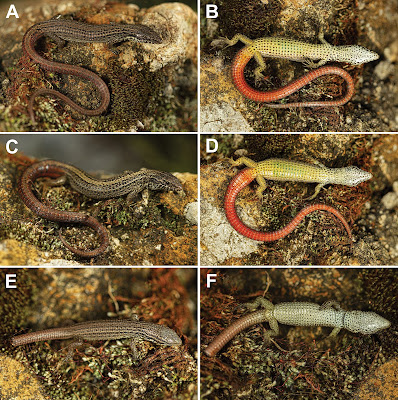We describe a new species of Selvasaura lizard from the western slopes of the eastern Andes of central Peru. Among other characters, the new species differs from congeners in having keeled dorsal scales and more transverse rows of scales on dorsum. We present a phylogeny as additional evidence supporting delimitation of the new species.
Key Words: New species, eastern Andes, central Peru, phylogeny
Selvasaura candesi sp. nov.
Diagnosis: A medium sized lizard (adult males SVL 28.3–49.5 mm, n=2) characterized by the following combination of morphological features: 1) body slender, dorsoventrally depressed in males, females unknown; 2) head slightly short, pointed, about 1.6 times longer than wide; 3) ear opening distinct, moderately recessed; 4) nasals separated by an undivided frontonasal; 5) prefrontals, frontal, frontoparietals, parietals, interparietal, and postparietals present; 6) parietals polygonal, slightly longer than wide; 7) supraoculars four, anteriormost fused (2 individuals) or not (1 individual) with anteriormost superciliary; 8) superciliary series complete, consisting in four scales; 9) nasal plate divided posterior to nostril; 10) loreal present, in contact with second supralabial; 11) supralabials seven; 12) genials in four pairs, first and second pairs in contact; 13) collar present, containing 9–10 enlarged scales; 14) dorsals in 40–41 transverse rows, rectangular, nearly twice as long as wide, subimbricate, keeled; 15) ventrals in 24–25 transverse rows; square to rectangular, juxtaposed, smooth; 17) scales around midbody 38–43; 18) lateral scales at midbody reduced in size, in 8–9 rows; 19) limbs pentadactyl, all digits clawed;20) forelimb reaching anteriorly the third supralabial; 21) subdigital lamellae under Finger IV 14–16; 22) subdigital lamellae under Toe IV 19–21; 23) femoral pores per thigh 9–10 in males; 24) rectangular preanal scales large, four in number; 25) tail about 0.4 times longer than body; 26) caudals larger than wide, subimbricate, rugose dorsally, smooth ventrally; 27) lower palpebral disc transparent, undivided; 28) dorsal surface of head, body and limbs brown with black speckling, dorsal surface of tail pale brown to reddish brown; a thick yellowish brown vertebral stripe on dorsum, a row of 1–2 faded black rings on each flank; throat creamy white with minute black spots or blotches within each scale; belly yellow (creamy white in juveniles) with minute black spots within each scale; ventral surfaces of limbs yellow or yellowish orange; anal area saffron yellow or reddish yellow; tail red or reddish orange in males (pale red in juveniles) with fine black speckling; iris pale orange in males.
Etymology: The specific epithet “candesi” refers to the acronym CANDES (Consultores Asociados en Naturaleza y Desarrollo) in recognition of their efforts supporting the herpetological research in Peruvian territory.
Germán Chávez, Luis A. García-Ayachi and Alessandro Catenazzi. 2023. A New Species of Microteiid Lizard (Gymnophthalmidae, Cercosaurini, Selvasaura) from A Remote Area in the Peruvian Andes. Evolutionary Systematics. 7(1): 123-132. DOI: 10.3897/evolsyst.7.99118




